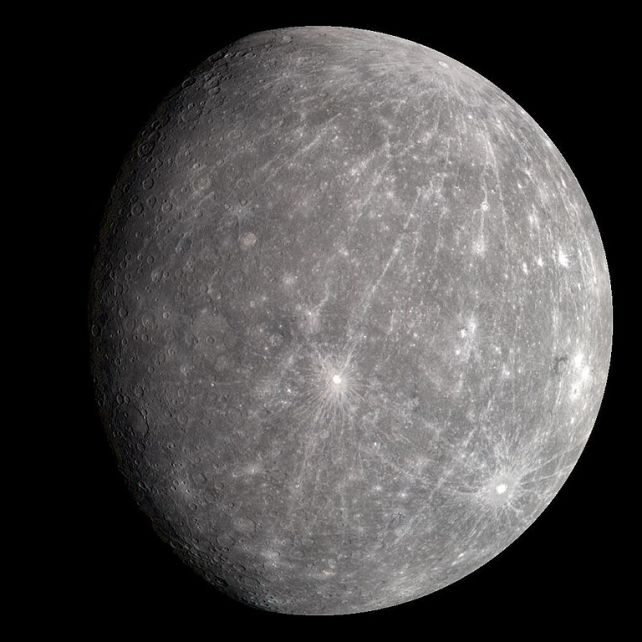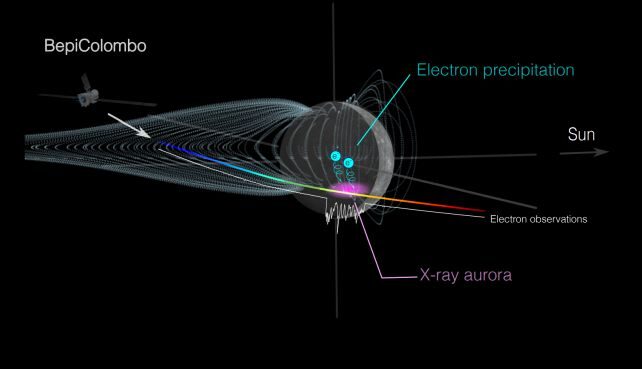In October 2021, the BepiColombo probe took measurements of electrons and ions at Mercury, finding evidence of their acceleration. Analysis showed that this was the result of auroral processes involving Mercury's magnetic field, ultimately producing a faint X-ray emission.
This means aurorae have now been seen on every single planet, suggesting that a mechanism for aurora production might be universal throughout the Solar System, in spite of the vast differences between the planets.
"Here, we show the direct evidence that strongly supports the view that energetic electrons are accelerated in the near-tail region of Mercury's magnetosphere, drift rapidly toward the dawn sectors, and are subsequently injected onto closed magnetic field lines on the planetary nightside," writes a team led by astrophysicist Sae Aiwaza of the University of Pisa in Italy.
"These observations reveal that electron injections and subsequent energy-dependent drift now observed throughout the Solar System is a universal mechanism that generates aurorae despite the differences in structure and dynamics of the planetary magnetospheres."
Generally, it's thought that two things are required for the production of this kind of aurora: a magnetic field, and an atmosphere. Particles are accelerated along magnetic field lines to a polar region, where they rain down into the atmosphere. There the charged particle's interactions with other atoms and molecules releases electromagnetic radiation, some of which we might see as a a colorful glow.
The charged particles mostly come from the solar wind, although Jupiter's powerful, permanent aurorae are mostly fed by electrons from its volcanic moon Io.
But Saturn has aurorae powered by the solar wind, too, as does Uranus. Auroral features were spotted on Neptune by Voyager 2 in 1989, but we've had no subsequent detections, so we don't have a good characterization of them.
It was expected that Mars and Venus would have no aurorae, as they lack global magnetic fields, but both planets surprised us. Mars has patches of magnetism on its surface that produce localized patches of aurora in the sky. And on Venus, magnetic fields from the Sun appear to help trigger atmospheric aurorae.
Mercury has a global magnetic field, but it's pretty weak. In addition, because Mercury is so close to the Sun, it is constantly buffeted by radiation and the solar wind. So the planet has no real atmosphere to speak of; it has a thin exosphere kicked up by solar wind and micrometeoroid bombardment. This exosphere is gravitationally bound to the planet, but too diffuse to behave as a gas.
Because of this, scientists thought Mercury unlikely to have aurora. And it also has, scientists have found, a surface that occasionally fluoresces in X-rays.
Aizawa and her colleagues used BepiColombo to track electrons in Mercury's vicinity, and found evidence of acceleration in the planet's magnetic field lines, precipitating towards the surface in areas, they found, that are consistent with the observed X-ray fluorescence. The fluorescence, they also found, is consistent with what we'd expect from this rain of electrons.
So, even without an atmosphere, and with a wimpy little magnetic field, Mercury seems to have found a way to create strange Mercurial aurorae, all of its very own, in minerals fluorescing X-radiation on the surface.
The research has been published in Nature Communications.





Comment: This comes on the heels of a discovery that Mercury has a magnificent comet-like tail.
The similarities between asteroids, comets, and even planets, are certainly curious; as Pierre Lescaudron writes in Earth Changes and the Human-Cosmic Connection: The following article from Mr Lescaudron sheds more light on the topic: The Seven Destructive Earth Passes of Comet Venus
And check out SOTT radio's: